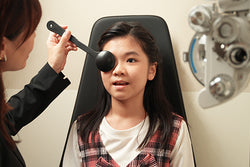
Understanding Floaters
Floaters are those peculiar shapes and specks that seem to drift aimlessly across your visual field. They can resemble tiny dots, squiggly lines, or even cobwebs and can often follow the movement of your eyeballs. While they may appear bothersome, these visual disturbances are usually harmless2.
Age, Floaters and Eye Health
Floaters primarily make their presence known as a result of the natural aging process. Within our eyes, there exists a gel-like substance called the vitreous, which, with time, undergoes changes. As the vitreous degenerates and its components clump together, it casts shadows on the retina, leading to the perception of floaters3.
In most cases, floaters are benign and do not necessitate intervention. They are a common occurrence, and many individuals experience them at some point in their lives. However, floaters may signal underlying eye conditions that demand prompt attention, for instance in the event of a retinal tear or detachment.
Causes of Floaters
- Vitreous Degeneration: The degeneration of the vitreous is the most common cause of floaters4.
- Retinal Tears and Detachment: Floaters may be accompanied by flashes of light or the sensation of a curtain across your vision, indicating a potential retinal issue5. This is an emergency that requires immediate medical attention.
- Eye Inflammation (Uveitis): Inflammatory conditions of the eye, such as uveitis, can cause white blood cells to enter the vitreous. These white blood cells can clump together and form floaters6.
- Eye Injuries
- Diabetes
Posterior Vitreous Detachment (PVD), Retinal Tear and Detachment
One notable condition related to floaters is posterior vitreous detachment (PVD)7. In PVD, the vitreous separates from the retina. Usually, this detachment does not require any treatment; however, it can sometimes lead to more serious issues if it tugs on the retina and leads to a retinal tear, which may trigger a retinal detachment. In such a situation, it necessitates immediate medical attention, as it can be sight threatening.
Risk Factors of Floaters
Posterior Vitreous Detachment is more commonly observed in individuals aged 50 and above, due to age-related degenerative changes within the eye8 . However, several risk factors can predispose someone to experience it at a younger age. These factors include myopia9, cataracts10, diabetes8, eye injury or surgery7.
How Regular Eye Examinations Can Help Detect Issues
Floaters are a frequent occurrence, often stemming from the natural aging of the eye. While they are typically harmless, it is essential to remain vigilant about any sudden changes in their appearance or if they are accompanied by other concerning symptoms. Regular eye check-ups can help detect and address potential issues, ensuring your eyes stay healthy and your vision remains clear.
Our eye care professionals at Spectacle Hut are well qualified to conduct a comprehensive eye exam for you. Book an appointment here at your nearest store.
1. Johnson, J. (2019, July 17). What to know about eye floaters. Medicalnewstoday.com; Medical News Today. https://www.medicalnewstoday.com/articles/325781
2. Health. (2021). Eye floaters. Vic.gov.au. https://www.betterhealth.vic.gov.au/health/conditionsandtreatments/eye-floaters
3. Are, W. (2022, November 29). What Are Floaters and Flashes? American Academy of Ophthalmology. https://www.aao.org/eye-health/diseases/what-are-floaters-flashes
4. Ask the ophthalmologist: What causes floaters in the eye? | Eyes and Vision | UT Southwestern Medical Center. (2022). Utswmed.org. https://utswmed.org/medblog/eye-floaters-flashes/
5. Retinal Detachment | National Eye Institute. (2022). Nih.gov. https://www.nei.nih.gov/learn-about-eye-health/eye-conditions-and-diseases/retinal-detachment
6. Bernstein, S. (2016, October 31). Why It’s Important to Treat Your Uveitis. WebMD; WebMD. https://www.webmd.com/eye-health/uveitis-complications
7. “Posterior Vitreous Detachment - Patients - the American Society of Retina Specialists.” Asrs.org, 2023, www.asrs.org/patients/retinal-diseases/9/posterior-vitreous-detachment
8. Bernstein, Susan. “Posterior Vitreous Detachment.” WebMD, WebMD, 27 Nov. 2016, www.webmd.com/eye-health/posterior-vitreous-detachment-facts
9. Hayashi K, Manabe SI, Hirata A, Yoshimura K. Posterior Vitreous Detachment in Highly Myopic Patients. Invest Ophthalmol Vis Sci. 2020 Apr 9;61(4):33. doi: 10.1167/iovs.61.4.33. PMID: 32334432; PMCID: PMC7401972.
10. Hilford, D., Hilford, M., Mathew, A. et al. Posterior vitreous detachment following cataract surgery. Eye 23, 1388–1392 (2009). https://doi.org/10.1038/eye.2008.273
← Older Post Newer Post →




